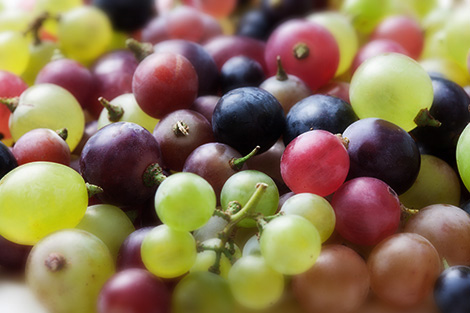Grape - Spain National Fruit
Fruit Information

Grapes hold profound cultural, religious and economic significance across many civilizations, featuring prominently in ancient mythologies, religious texts and artistic expressions. Wine made from grapes has been central to religious ceremonies, social gatherings and cultural identity for millennia. Modern grape processing has expanded beyond traditional wine and raisin production to include grape seed extracts, grape-based supplements, cosmetic products and various functional foods. The industry continues to innovate with new varieties, sustainable farming practices and value-added products, while maintaining deep connections to traditional winemaking and grape-growing heritage that defines many regional cultures worldwide.
| Fruit Name | Grape |
| Scientific Name | Vitis Vinifera |
| Country | Spain |
| Continent | Europe |
| Fruit Season | Fall |
| Fruit Color | Purple-Green-Red |
| Fruit Size | Small |
| Fruit Taste | Sweet-Complex |
| Fruit Origin Region | Mediterranean |
| Designation Year | 1978 |
| Peak Month | September-October |
| Economic Importance | World Wine Leader |
| Cultural Use | Spanish wine culture, Mediterranean diet |
| Processing Type | Wine, Fresh, Raisins, Juice |
| Fruit Shape | Round small clusters |
| Texture | Juicy and Firm |
| Nutritional Value | Antioxidants, Resveratrol, Vitamin C |
| Storage Type | Refrigerated |
| Harvest Method | Hand and machine harvest |
| Shelf Life | 1-3 weeks |
| Climate Type | Mediterranean |
| Soil Type | Chalky limestone |
| Water Requirement | Moderate |
| Tree Height | 1-3 meters (vine) |
| Flowering Season | April-June |
| Fruiting Age | 3-4 years |
| Yield Per Tree | 5-15 kg per vine |
| Export Countries | Spain, Italy, France |
| Import Countries | Germany, UK, USA |
| Medicinal Use | Heart health, Anti-aging |
| Festival Association | La Vendimia, Wine harvest festivals |
| Historical Significance | Ancient Roman viticulture |
| Alternative Names | Uva, Spanish Grape, Vino |
Detailed Information
Cultivation & Origin
Grape cultivation has expanded globally from its Middle Eastern origins, with major production regions now including Europe (France, Italy, Spain), Americas (United States, Chile, Argentina) and other areas with Mediterranean-like climates. The industry encompasses thousands of grape varieties, broadly categorized into table grapes for fresh consumption, wine grapes for fermentation and raisin grapes for drying. Modern viticulture employs sophisticated techniques including clonal selection, precision pruning, canopy management and harvest timing optimization to achieve desired flavor profiles and quality characteristics specific to intended end uses.
Nutritional Benefits
From a nutritional standpoint, grapes offer impressive health benefits due to their rich antioxidant content, particularly flavonoids like quercetin, catechins and anthocyanins, which provide anti-inflammatory and cardioprotective effects. The famous compound resveratrol, found primarily in grape skins, has been extensively studied for its potential anti-aging, neuroprotective and cancer-preventive properties. Grapes contain natural sugars that provide quick energy, while their water content helps with hydration. The fruit also supplies vitamin K for bone health, vitamin C for immune support and potassium for cardiovascular function and fluid balance.
Economic & Agricultural Significance
The global grape industry represents one of the most economically significant agricultural sectors, encompassing fresh fruit markets, wine production, raisin manufacturing and juice processing. Wine production alone generates hundreds of billions of dollars annually and supports complex supply chains involving growers, processors, distributors and retailers worldwide. Climate change presents both challenges and opportunities for grape cultivation, with traditional wine regions facing temperature increases while new areas become suitable for viticulture. Sustainable practices including organic farming, water conservation and carbon-neutral production methods are increasingly adopted across the industry.
Cultural & Modern Applications
Grapes hold profound cultural, religious and economic significance across many civilizations, featuring prominently in ancient mythologies, religious texts and artistic expressions. Wine made from grapes has been central to religious ceremonies, social gatherings and cultural identity for millennia. Modern grape processing has expanded beyond traditional wine and raisin production to include grape seed extracts, grape-based supplements, cosmetic products and various functional foods. The industry continues to innovate with new varieties, sustainable farming practices and value-added products, while maintaining deep connections to traditional winemaking and grape-growing heritage that defines many regional cultures worldwide.